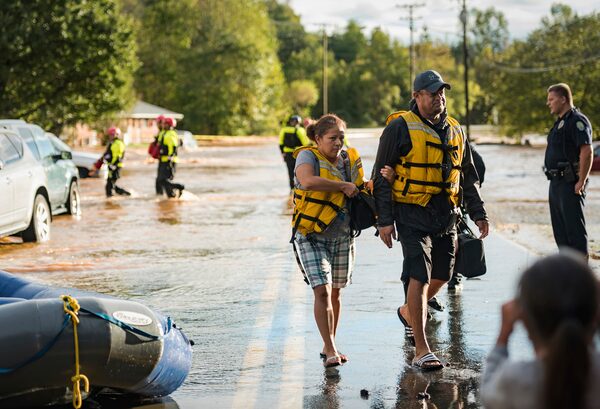First responders and residents walk along a main street following Hurricane Michael in Mexico Beach, Fla., on Oct. 11, 2018.CARLO ALLEGRI/Reuters
The death toll from Hurricane Michael rose to 17 across four states on Friday, law-enforcement officials said, as rescue crews hampered by communications failures searched the hardest-hit communities in the Florida Panhandle. Searchers found one person dead in the rubble of Mexico Beach, said Joseph Zahralban, Miami’s fire chief and the task-force leader of a search and rescue unit. Three additional deaths were reported in Marianna, in Jackson County, Fla., Sheriff Lou Roberts told a news conference on Friday afternoon.
The number of fatalities was expected to rise further as rescuers go door to door and comb through the rubble in oceanfront communities such as Mexico Beach, Port St. Joe and Panama City that bore the brunt of the storm’s wrath.
“I think you’re going to see it climb,” Brock Long, administrator of the Federal Emergency Management Agency (FEMA), said of the death count. “We still haven’t gotten into some of the hardest-hit areas.”
Tropical Storm Michael has devastated Florida, Georgia and the Carolinas. Here’s what we know
The dead include at least eight people in Florida, five in Virginia, three in North Carolina and one in Georgia.
FEMA crews have been using bulldozers and other heavy equipment to push a path through debris to allow rescuers to probe the rubble with sniffer dogs.
Michael blew ashore near the small Florida Panhandle town of Mexico Beach on Wednesday afternoon as one of the most powerful storms in U.S. history, with winds of up o 155 miles an hour (250 kilometres an hour). It pushed a wall of seawater inland, causing widespread flooding.
The storm, which in less than two days grew from a tropical storm to a Category 4 hurricane on the five-step Saffir-Simpson scale, tore apart entire neighbourhoods in the Panhandle, reducing homes to naked concrete foundations or piles of wood and siding.

Alma Archer and Edgar Leyva walk to drier land after the Winston-Salem Fire Department's water rescue team helped them down from their apartment in Winston-Salem, N.C., on Oct. 11, 2018.Allison Lee Isley/The Associated Press
NO PHONE, INTERNET
Except for the emergency-911 system, authorities in Bay County, the epicentre of the hurricane disaster, were virtually without telephone or internet service until late in the day on Friday, making communications internally and with the public difficult.
“We didn’t have anything. We’ve been writing things down on pieces of paper,” said Ruth Corley, a spokeswoman for the Bay County Sheriff’s Department. “We’re doing what we can with the minimal media that we have.”
She said local television stations were knocked off the air for two days, and that authorities were relying on the radio station of the Gulf Coast State College to broadcast public-service bulletins.
She said search teams have been going door-to-door in Mexico Beach and other hard-hit areas of the county looking for possible storm victims who may have been trapped or killed.
Bay County officials have previously said 56 people chose to stay in their homes in Mexico Beach and that search and rescue teams were trying to account for those people.
Social-media websites were filled with messages from people trying to reach missing family members in Florida’s Bay and Gulf Counties.
Locals offered to go to addresses to see if houses had survived or if residents were there. The National Oceanic and Atmospheric Administration (NOAA) provided a website with satellite images for people to check on the condition of homes.
REBUILD RIGHT
FEMA’s Mr. Long urged communities such as Mexico Beach, where many homes were obliterated by 12 to 14 feet (3.7 to 4.3 meters) of storm surge, to rebuild to withstand future storms.
“It’s okay if you want to live on the coast or on top of a mountain that sees wildfires or whatever, but you have to build to a higher standard,” he said. “If we’re going to rebuild, do it right.”
By Friday morning, the remnants of Michael had moved into the Atlantic Ocean northeast of Norfolk, Va., but still could bring up to 5 inches (13 cm) of rain to parts of New England, the National Hurricane Center said.
About 1.5 million homes and businesses were without power from Florida to Virginia on Friday, according to utility companies.
It could be weeks before power is restored to the most damaged parts of Florida.
The number of people in emergency shelters was expected to swell to 20,000 across five states by Friday, said Brad Kieserman of the American Red Cross. The Coast Guard reported rescuing 129 people.
Even as rescuers searched the rubble for survivors or the deceased, some residents of Mexico Beach were nervously trickling back on Friday, expressing hope the place, nicknamed “the Forgotten Coast,” would not change too much as it rebuilds.
“It was the perfect beach town. Not all of that commercialism,” said Dottie Sinclair, 57, a nurse, adding a Subway fast-food restaurant was the only commercial chain.
“I don’t think it will ever be the same,” said husband Danny Sinclair, 64, who is semi-retired. “People will just pack up and leave.”